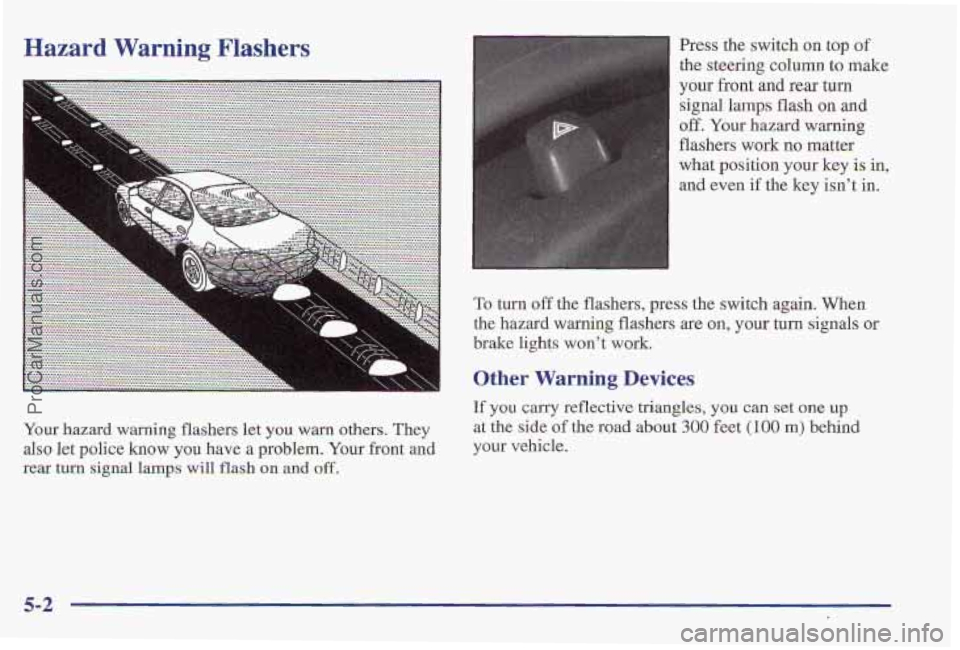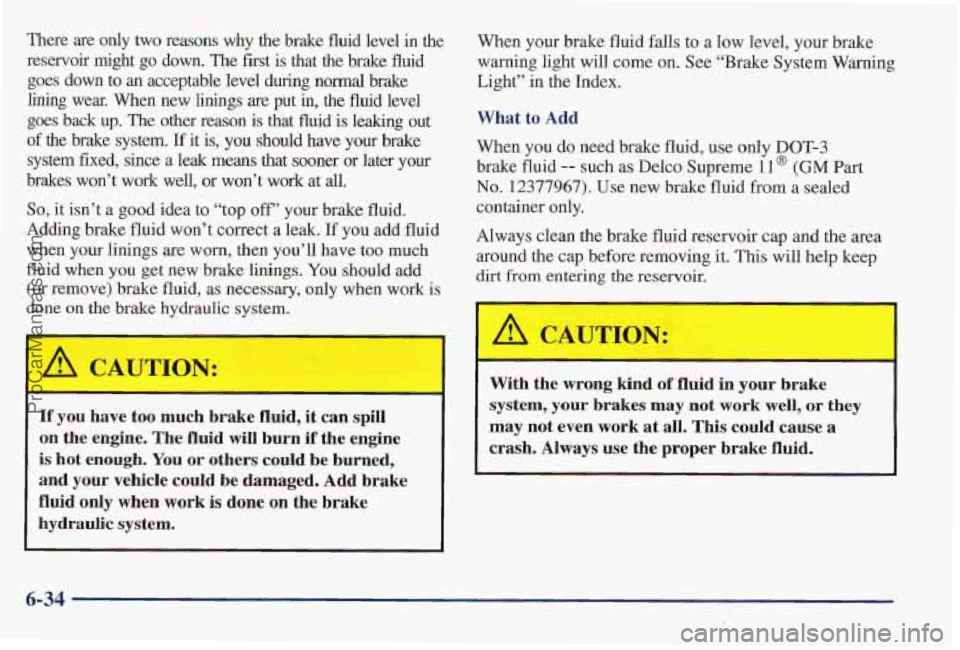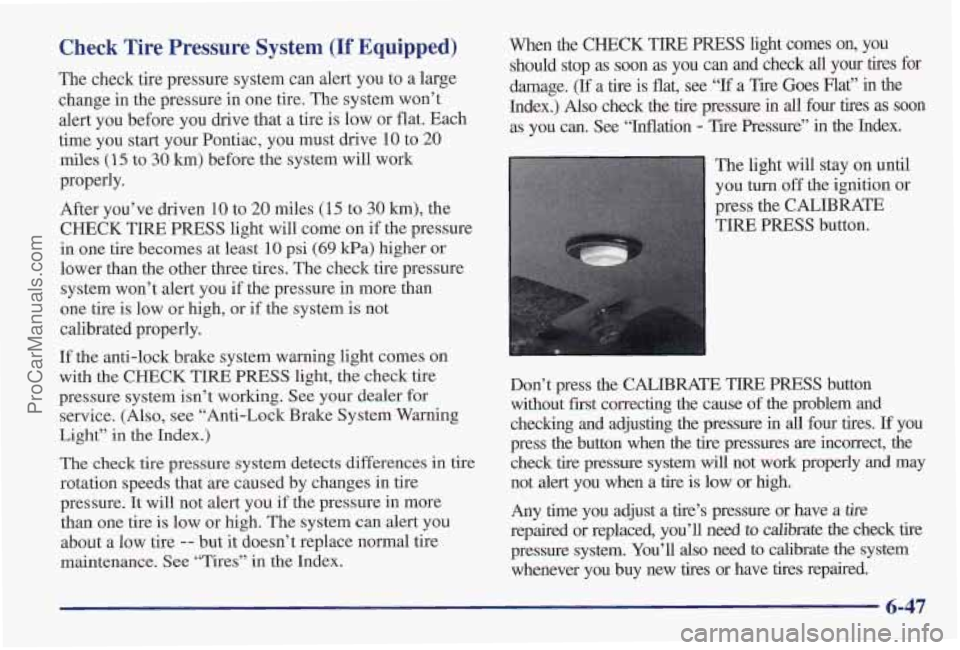1997 PONTIAC PONTIAC brake light
[x] Cancel search: brake lightPage 212 of 419

The heavier the rain, the harder it is to see. Even if your
windshield wiper blades are in good shape, a heavy rain
can make it harder to see road signs and traffic signals,
pavement markings, the edge
of the road and even
people walking.
It’s wise to keep your windshield wiping equipment
in good shape and keep your windshield washer tank
filled with washer fluid. Replace your windshield wiper
inserts when they show signs
of streaking or missing
areas on the windshield, or when strips
of rubber start to
separate from
the inserts. Driving
too fast through large water puddles
or even
going through some car washes can cause problems, too.
The water
may affect your brakes. Try to avoid puddles.
But if you can’t, try to slow down before you hit them.
Wet brt L c% le accidents. They won’t work
as well
in a quick stop and may cause pulling to
one side.
You could lose control of the vehicle.
After driving through a large puddle of water or
a car wash, apply your brake pedal lightly until
your brakes work normally.
4-18
ProCarManuals.com
Page 231 of 419

Making Turns
I NOTICE:
Making very sharp turns while trailering could cause the trailer to come in contact with the
vehicle. Your vehicle could be damaged. Avoid making very sharp turns while trailering.
When you’re turning with a trailer, make wider turns than
normal.
Do this so your trailer won’t strike soft shoulders,
curbs, road signs, trees or other objects. Avoid jerky or
sudden maneuvers. Signal well in advance.
Turn Signals When Towing a Trailer
When you tow a trailer, your vehicle may need a
different turn signal flasher andlor extra wiring. Check
with your Pontiac dealer. The green arrows on your
instrument panel will flash whenever you signal a turn
or lane change. Properly hooked up, the trailer lamps
will also flash, telling other drivers you’re about to turn,
change lanes or stop. When towing
a trailer, the green
arrows on your
instrument panel will flash for turns even if the bulbs on
the trailer are burned out. Thus, you may think drivers
behind you are seeing your signal when they are not. It’s
important to check occasionally to be
sure the trailer
bulbs
are still working.
Your vehicle has bulb warning lights. When you plug
a
trailer lighting system into your vehicle’s lighting
system, its bulb warning lights may not
let you know if
one of your lamps goes out. So, when you have a trailer
lighting system plugged in, be sure to check your
vehicle and trailer lamps
from time to time to be sure
they’re all working. Once you disconnect the trailer
lamps, the bulb warning lights again can tell you if one
of your vehicle lamps is out.
Driving On Grades
Reduce speed and shift to a lower gear before you start
down a long or steep downgrade. If you don’t shift
down, you might have to use your brakes
so much that
they would get hot and no longer work well.
On
a long uphill grade, shift down and reduce your
speed to around
45 mph (70 kd) to reduce the
possibility
of engine and transaxle overheating.
If you have Overdrive, you may want to drive in
THIRD (3), instead of DRIVE (D),
4-37
ProCarManuals.com
Page 236 of 419

Hazard Warning Flashers Press the switch OB top of
the steering column to make
your front and
rear turn
signal lamps
flash on and
off. Your hazard warning
flashers
work no matter
what position your key
is in,
and even if the key isn’t in.
Your hazard warning flashers let you warn others. They
also let police know
you have a problem. Your front and
rear
turn signal lamps will flash on and off.
To turn off the flashers, press the switch again. When
the hazard warning flashers are
on, your turn signals or
brake lights won’t work.
Other Warning Devices
If you carry reflective triangles, you can set one up
at the side of the road about 300 feet (100 m) behind
your vehicle.
5-2
ProCarManuals.com
Page 247 of 419

Attach a separate safety
chain around the outboard
end
of both lateral arms.
Please take care not to
damage speed sensor
wires or brake
hoses
when attaching chains
l.1 and T-hooks. -
Engine Overheating
You will find a coolant temperature gage and a warning
light about
a hot engine on your instrument panel. See
“Engine Coolant Temperature Gage” and “Engine
Coolant Temperature Warning Light” in the Index.
You
also have a low coolant light on your instrument panel.
Sed‘Low Coolant Light” in the Index.
If Steam Is Coming From Your Engine
Steam from an overheated engine can burn you
badly, even if you just open the hood. Stay away
from the engine if you see or hear steam coming
from it. Just turn it off and get everyone away
from the vehicle until it cools down. Wait until
CAUTION: (Continued)
5-13
ProCarManuals.com
Page 304 of 419

There are only two reasons wny the brake fluid level in the
reservoir might go down. The first is that the brake fluid
goes down to an acceptable level during normal brake
lining wear. When new linings are put in, the fluid level
goes back
up. The other reason is that fluid is leaking out
of the brake system. If it is, you should have your brake
system fixed, since a leak means that sooner or later your
brakes won’t work well, or won’t work at all.
So, it isn’t a good idea to “top off’ y’our brake fluid.
Adding brake fluid won’t correct a leak. If you add fluid
when your linings are worn, then you’ll have
too much
fluid when
you get new brake linings. You should add
(or remove) brake fluid, as necessary, only when work
is
done on the brake hydraulic system.
If you have too much brake fluid, it can spill
on the engine. The fluid will burn
if the engine
is hot enough. You or others could be burned,
and your vehicle could be damaged. Add brake
fluid only when work
is done on the brake
hydraulic system. When your brake
fluid falls
to a low level, your brake
warning light will come on. See “Brake System Warning
Light” in the Index.
What
to Add
When you do need brake fluid,
use only DOT-3
brake fluid -- such as Delco Supreme 11 @ (GM Part
No. 12377967). Use new brake fluid from a sealed
container only.
Always clean the brake fluid reservoir cap and
the area
around the cap before removing
it, This will help keep
dirt from entering the reservoir.
With the wrong kind
of fluid in your brake
system, your
brakes may not work well, or they
may not even work at all. This could cause
a
crash. Always use the proper brake fluid.
6-34
ProCarManuals.com
Page 306 of 419

Some driving conditions or climates may cause a brake
squeal when the brakes are first applied or lightly
applied.
This does not mean something is wrong with
your brakes.
Properly torqued wheel
nuts are necessary to help
prevent brake pulsation, When tires are rotated, inspect
brake pads for wear, and evenly torque wheel nuts in
the proper sequence
to GM specifications.
Brake linings should always be replaced as complete
axle sets.
See “Brake System Inspection” in section
7 of this
manual under
Part C “Perodic Maintenance Inspections,”
Brake Pedal Travel
See your dealer if the brake pedal does not return to
normal height,
or if there is a rapid increase in pedal
travel. This could be a sign of brake trouble.
Brake Adjustment
Every time you apply the brakes, with or without the
vehicle moving, your
brakes adjust for wear.
Replacing Brake System Parts
The braking system on a modern vehicle is complex. Its
many parts have to be of top quality and work well
together if the vehicle is to have really good braking.
Vehicles we design and test have top-quality
GM brake
parts in them,
as your Pontiac does when it is new.
When you replace parts of your braking system
-- for
example, when your brake linings wlear down and you
have to have new ones put in
-- be sure you get new
approved
GM replacement parts. If you don’t, your
brakes may no longer work properly. For example,
if
someone puts in brake linings that are wrong for your
vehicle, the balance between your front and rear brakes
can change -- for the worse. The braking performance
you’ve come to expect can change in many other ways
if
someone puts in the wrong replacement brake parts.
Battery
Every new Pontiac has a Delco Freedom@ battery. You
never have
to add water to ‘one of these. When it’s time
for a new battery, we recommend a Delco Freedom
battery. Get one that has
the replacement number shown
on the original battery’s label.
ProCarManuals.com
Page 317 of 419

Check Tire Pressure System (If Equipped)
The check tire pressure system can alert you to a large
change in the pressure in one tire. The system won’t
alert you before you drive that a tire is low or flat. Each
time you start your Pontiac, you must drive
10 to 20
miles (15 to 30 km) before the system will work
properly.
After you’ve driven
10 to 20 miles (15 to 30 km), the
CHECK TIRE PRESS light will come on if the pressure
in o’ne
tire becomes at least 10 psi (69 kPa) higher or
lower than the other three tires. The check tire pressure
system won’t alert you if the pressure in more than
one tire is low or high, or if the system is not
calibrated properly.
If the anti-lock brake system warning light comes on
with the
CHECK TIRE PRESS light, the check tire
pressure system isn’t working. See your dealer for
service. (Also, see “Anti-Lock Brake System Warning
Light” in
the Index.)
The check tire pressure system detects differences in tire
rotation speeds that are caused by changes in tire
pressure. It will not alert you if the pressure in more
than one tire is low or high. The system can alert you
about
a low tire -- but it doesn’t replace normal tire
maintenance. See “Tires” in
the Index. When
the CHECK
TIRE PRESS light comes on, you
should stop as soon
as you can and check all your tires for
darnage. (If a tire
is flat, see “If a Tire Goes Flat” in the
Index.) Also check the tire pressure in all four tires as soon
as you can. See “Inflation - Tire Pressure” in the Index.
The light will stay on until
you turn off the ignition
or
press the CALIBRATE
TIRE
PRESS button.
Don’t press the CALIBRATE TIRE
PRESS button
without first correcting the cause of the problem and
checking and adjusting the pressure in all four tires.
If you
press the button when the tire pressures
are incorrect, the
check tire pressure system will not work properly
and may
not alert you when a tire is low or high.
Any time you adjust a tire’s pressure or have a
tire
repaired or replaced, you’ll need to calibrate the check tire
pressure system. You’ll
also need to calibrate the system
whenever you buy new tires or have
tires repaired.
6-47
ProCarManuals.com
Page 407 of 419

v Section 9 Index
Accessory Power Outlet .................... 2.57. 2.59
AirBag
....................................... 1-22
How Does it Restrain
.......................... 1-26
How it Works
................................ 1-24
Location
.............. .......... 1-24
Readiness Light
......................... 1.23. 2.65
Servicing
................................... 1-27
What Makes it Inflate
.......................... 1-25
What Will
You See After it Inflates ............... 1-26
When
Should it Inflate ......................... 1-25
Air Cleaner
.................................... 6- 19
Air Conditioning ............................ 3.3. 3.7
Air Conditioning Refrigerants ..................... 6-73
Alignment and Balance. Tire ...................... 6-52
Aluminum Wheels. Cleaning
...................... 6-61
Antifreeze ..................................... 6-27
Anti-Lock
Brake System Warning Light
................ 2.67. 4.7
Brakes
...................................... 4.7
Anti.Theft. Radio .............................. 3-26
Appearance
Care ............................... 6-55
Appearance Care Materials ....................... 6-64
Arbitration Program
.............................. 8-9
Ashtrays ...................................... 2-58 Audio Controls. Steering Wheel
Touch Control
....... 3-29
Audio Equipment. Adding
........................ 3-30
Audio Systems
................................. 3-10
Auto-Down Window
............................ 2-31
Automatic
Auxiliary Temp Control
......... ........ 3-4
Check
...................................... 7-40
Door Locks
.............................. 2-6, 2-46
Electronic Climate Control
...................... 3-2
Fluid
....................................... 6-21
Operation
................................... 2-19
Overdrive
............................... 2-21
Park Mechanism Check . ......... 7-42
Back Glass Antenna ........ .... 3-32
Battery
....................................... 6-36
Jump Starting ................................. 5-3
Replacement, Remote Keyless Entry
.............. 2-10
Resynchronization, Remote Keyless Entry ......... 2-11
Warnings
................................ 5-3, 5-5
Battery Saver .................................. 2-42
BBB Auto Line ................................. 8-9
Better Business Bureau Mediation
................... 8-9
9-1
ProCarManuals.com